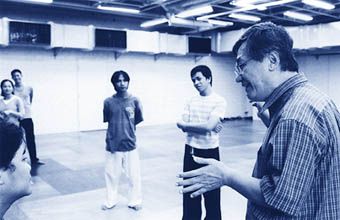Obituary: Kuo Pao Kun
Robert Draffin

Kuo Pao Kun (right)
Kuo Pao Kun died at the age of 63, September 10, 2002. When a spirit such as his passes away, the soul of the world weeps. He was a multi-lingual writer, theatre director and teacher who had an innate ability to work deeply with people. As the artist Tan Swee Hien’s calligraphy said next to his coffin, “From the mountain cave comes a thunderous cloud.” He leaves a large legacy and a unique vision.
Born in Hebei in China in 1939, Pao Kun witnessed the Japanese invasion and the Peoples’ Liberation Armies takeover of Peijing (Beijing). As a boy in 1949 Pao Kun travelled to live with his father in Singapore. He came to Australia in 1959 to work as translator for Radio Australia. He matriculated from Melbourne University and studied at NIDA in 1963. When he returned to Singapore in 1965 with his wife Goh Lay Kuan, he set up a performing arts school, a theatre company, Theatre Practice, and later created the alternative theatre venue The Substation.
He mastered Chinese, English and Malay and became a well know dramatist, educator and cultural activist. In 1976 he was imprisoned by the Singaporean Government for 4 years for his writings and activities, but in 1990 the same government awarded him the Cultural Medallion. In 1996 the French Government conferred on him the Chevalier de l’Ordre des Arts et des Lettres.
His links to Australia were significant and many Australian writers, actors and directors have been influenced by both the man and his ideas. His theatre experiences in Australia and South East Asia helped shape his very particular worldview. He was able to live with the contractions, ambiguities and multiple connections of the east and the west and sit comfortably in both traditional and contemporary artistic practice. He did not identify with, or make academic comparisons but absorbed and fused them, continually standing on the threshold of something unknown and inspiring. Through him, so many of us in Australia were informed, challenged and able to access and find a deeper meaning in our association with Asia and Asian artists. He gave direction to our place in Asia.
He began writing in 1968 from a socio-political position; later his plays took on a deeply reflective and spiritual tone. The immensity of and the esteem for his work was apparent to me at the launch of his collected works, Images at the Margins: A collection of Kuo Kun’s Plays in May 2000—his plays were in production in Japan, Malaya, Indonesia and China. In the Middle East, Asia and the West he is one of Asia’s most important, most performed and most studied contemporary playwrights.
Pao Kun had an ability to discover and foster the potential of young Asian artists. Fifteen years ago he brought together many writers who at the time were unknown or unpopular. One was Gao Xing Jian who was later awarded the Nobel Prize for Literature, and the other, Danny Yung, became one of Hong Kong’s key arts and cultural planners. In Singapore there is not a major performing artist who has not at some time been influenced by the teachings or work of Pao Kun. When he died he was still involved in the Theatre Training Research Program (TTRP) aimed at finding a distinctly Asian contemporary acting methodology. Through his contribution Singapore has become a strategic cultural centre.
The man was clear, honest and compassionate, deeply and continually fascinated with people’s complexities. Commenting on his 4 years of solitary detention, he held no malice. He saw it as a furnacing process forcing him to look reality straight in the face; he said the purging effect was total and deep.
Pao Kun made culture manifest. He was a creator, a discoverer, a selector, an organiser, and a friendship weaver. The task of condensing his life into a few words is daunting: the nature of the man and size of his deeds defies words. I see him now in his sarong and white singlet, sitting, looking over the rim of his glasses, tilting his head and saying, “Why do you waste your time writing about me?”
Many people in Australia have loved this great man and will mourn his passing. The thunderous cloud remains. Wherever we are from, many will stand, face south and take a deep bow. “We miss ya already PK.”
In writing this I am indebted to A Centurial Role Model: remembering Kuo Pao Kun by Qui Yu (Shanghai), and Goh Lay Kuan and Chee Keng (TTRP Singapore). www.ppas.edu.sg
RealTime issue #52 Dec-Jan 2002 pg. 34






